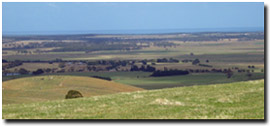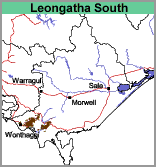Leongatha South (Ls)
 View from near Kongwak overlooking areas of the Leongatha South mapping unit to the coast. |  |
Geology
Tertiary and Early Pleistocene sediments.
Landform
Gently undulating rises.
Soils
Apart from soils in drainage depressions (Component 4), the surface soils range from very dark grey silty clay loams or sandy loams. The surface overlies a light grey or light brownish grey similarly textured subsurface soil at about 20 cm which develops yellowish brown mottles with depth. Below the bleached zone the subsoils are quite variable. It is convenient to separate the soils into three components (Components 1, 2 & 3) on the basis of subsoil differences but at the present scale of mapping it is not possible to separate them on the soil map.
Component 1
Clays occur immediately below the bleached zone. These are medium to heavy clays and occur from about 50 to 70 cm. Generally they are mottled light grey and yellowish brown.
Component 2
Below the bleached zone, at about 40 to 50 cm, the subsoil changes clearly to a light brownish grey, mottled with yellowish brown light clay to sandy clay. Mottled light brownish grey and yellowish brown medium to sandy clays occur from about 80 cm. Soft rock may occur below 1.5 m depth.
Component 3
A zone of variably cemented "coffee rock" occurs below the bleached zone at about 40 or 50 cm. Colours vary but they are predominantly dark grey and strong brown. Below the "coffee rock", light grey and yellowish brown variably cemented sandy clay loams to sandy clays occur which in turn overlie similarly coloured medium to heavy clays (Soil Site SG3 is an example of a Podosol formed within an older Kurosol that occurs within this unit).
Component 4
These are soils which occur in the drainage depressions. They occupy less than 10% of this mapping unit. Insufficient information has been recorded to provide a reliable description of this component.
Occurrence
These soils mainly occur south of Leongatha.


